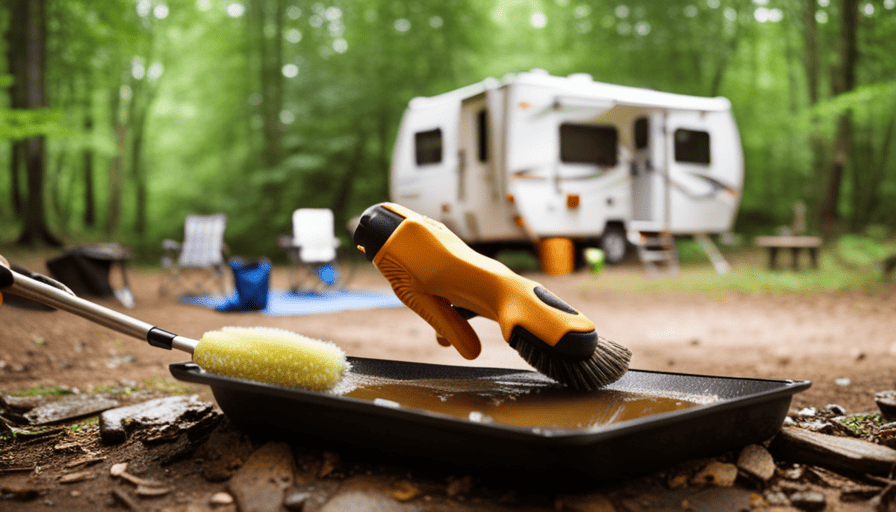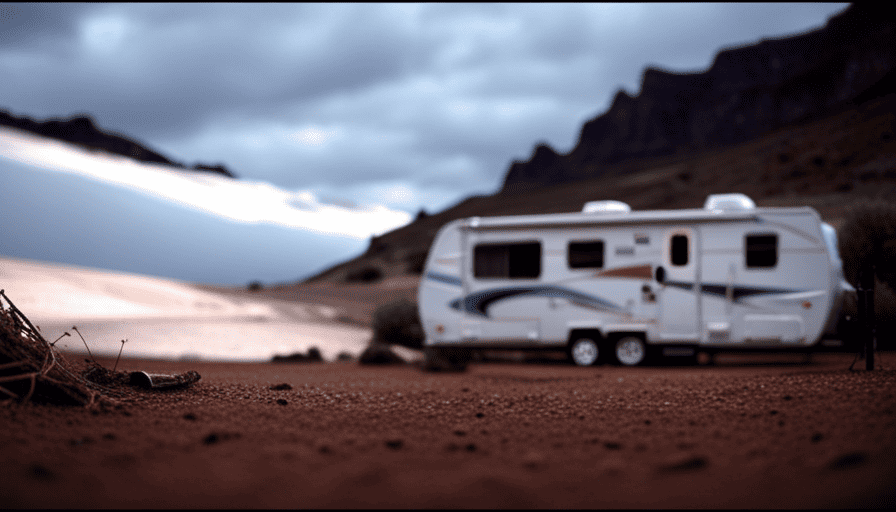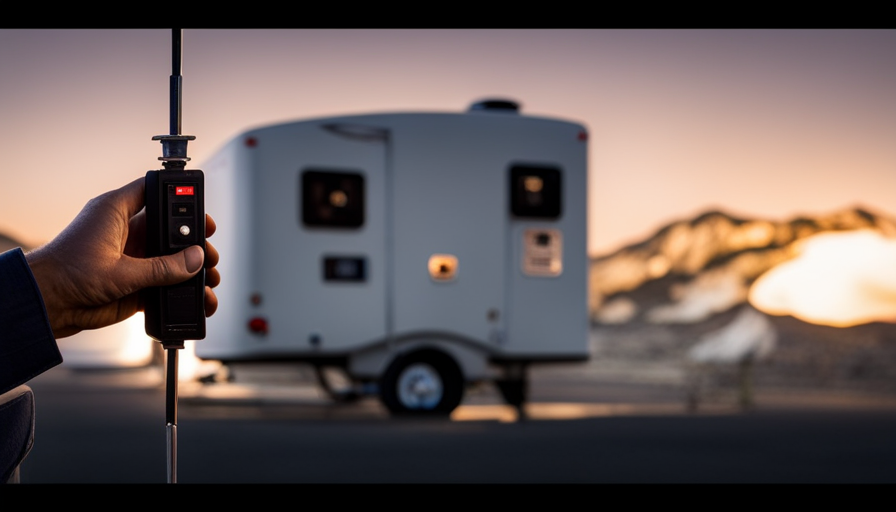You might be thinking that charging a camper battery seems like a big challenge. However, don’t worry, as I’m here to lead you through each step of the process. No matter if you’re an experienced camper or just beginning, understanding how to charge your camper battery is crucial for a successful outing.
In this article, I will provide you with all the necessary information to charge your camper battery effectively. We will start by understanding the different types of camper batteries and determining the specific charger you need.
I will also walk you through gathering the required equipment and connecting the charger to your battery.
But it doesn’t stop there. I will show you how to set the charging parameters correctly and safely disconnect the charger once the battery is fully charged. Additionally, I will provide tips for regular maintenance of your camper battery and alternative charging methods.
So, let’s get started and ensure your camper battery is always ready to power your adventures!
Key Takeaways
- Understanding different battery types is important for charging a camper battery.
- Regular maintenance, such as checking electrolyte levels and cleaning terminals, is necessary for optimal performance.
- Selecting the right charger depends on battery chemistry, capacity, charging method, and safety features.
- Monitoring the charging process through voltage and amperage helps maximize battery lifespan and minimize charging time.
Understand Your Camper Battery
So you’ve got yourself a camper battery, huh? Well, it’s time to dive in and understand how it works! When it comes to battery maintenance, it’s important to know the ins and outs of your camper battery.
One key factor to consider is the battery capacity. This refers to the amount of energy the battery can store and deliver. It’s measured in amp-hours (Ah). The higher the capacity, the longer your battery can power your camper.
To ensure optimal performance and longevity of your battery, regular maintenance is essential. This includes checking the battery’s electrolyte levels, cleaning the terminals, and ensuring proper ventilation. Additionally, it’s important to monitor the battery’s charge level to prevent overcharging or discharging, as this can damage the battery.
Now that you understand the basics of your camper battery, it’s time to determine the type of charger you need. This will depend on factors such as the battery’s chemistry (lead-acid, lithium-ion, etc.) and the desired charging speed. By selecting the right charger, you can ensure efficient and safe charging for your camper battery.
Determine the Type of Charger You Need
First, figure out the specific type of charger you’ll need to power up your camper’s battery. Selecting the appropriate charger is crucial to ensure efficient and safe charging. Here are four key considerations to help you determine the correct voltage:
-
Battery Type: Different types of camper batteries require different charging voltages. Lead-acid batteries, for instance, typically need a charger with a higher voltage range, while lithium-ion batteries require a charger designed specifically for their lower voltage range.
-
Battery Capacity: The charger you choose should match the capacity of your camper battery. A higher capacity battery will require a charger with a higher amperage output to charge it effectively.
-
Charging Method: Determine whether you need a portable charger or a charger that can be permanently installed in your camper. Portable chargers are more versatile, allowing you to charge the battery anywhere, while a permanent charger offers the convenience of always being connected.
-
Safety Features: Look for chargers with built-in safety features, such as overcharge protection and reverse polarity protection, to prevent damage to your battery and ensure safe charging.
Selecting the appropriate charger and understanding the correct voltage for your camper battery is essential for successful charging. Now that you know what type of charger you need, let’s move on to gathering the necessary equipment.
Gather the Necessary Equipment
Once you’ve determined the type of charger you need for your camper, it’s time to gather all the gear you’ll require.
The first piece of equipment you’ll need is the charger itself. Make sure it’s compatible with your camper’s battery type and has the necessary voltage and amperage ratings.
Additionally, you’ll need a power source, such as a generator or an electrical hookup at a campsite. If you’re using a generator, ensure it has enough capacity to handle the charger’s requirements.
Next, gather the necessary cables and connectors to connect the charger to your camper battery. These should be of good quality and capable of handling the charger’s output.
It’s also a good idea to have a voltmeter or multimeter to monitor the charging process and ensure the battery is properly charging.
Finally, consider investing in battery maintenance equipment such as a battery desulfator or a battery tender. These devices can help extend the life of your camper battery and keep it in optimal condition.
With all your charging equipment and battery maintenance tools in hand, you’re ready to move on to the next step of connecting the charger to your camper battery, ensuring a proper and efficient charge.
Connect the Charger to Your Camper Battery
To ensure a seamless and efficient power supply for your camper, it’s time to connect the charger directly to your camper’s battery. Choosing the right charger is crucial to ensure optimal charging performance. Look for a charger that’s compatible with your battery’s type and capacity. It should also have the correct voltage and amperage output to meet the charging requirements of your battery.
Before connecting the charger, it’s important to take safety precautions. Make sure the charger’s unplugged and turned off before starting. Inspect the charger and cables for any signs of damage. Ensure that the charger’s positive and negative terminals are clearly marked and that the polarity’s correct. This’ll prevent any accidental short-circuits or damage to the battery.
To connect the charger, start by connecting the positive terminal of the charger to the positive terminal of the battery. Then, connect the negative terminal of the charger to the negative terminal of the battery. Double-check the connections to ensure they’re secure and tight.
Now that the charger’s connected to your camper’s battery, you can proceed to the next step of setting the charging parameters. It’s important to set the parameters correctly to avoid overcharging or undercharging your battery.
Set the Charging Parameters
Make sure you’re aware of the specific charging parameters required for your battery to ensure a smooth and efficient power supply for your camper. One important parameter to consider is the charging time. Different batteries have different charging times, and it’s crucial to follow the manufacturer’s recommendations in order to avoid overcharging or undercharging.
Overcharging can lead to battery damage and reduced lifespan, while undercharging can result in a battery that isn’t fully charged and may not provide enough power for your camper’s needs.
Another parameter to keep in mind is the battery capacity. This refers to the amount of energy the battery can store and deliver. It’s important to match the charger’s capacity to the battery’s capacity to ensure a proper charge. Using a charger with a lower capacity may result in a longer charging time, while using a charger with a higher capacity may potentially damage the battery.
Once you’ve set the charging parameters correctly, you can now proceed to monitor the charging process. By keeping an eye on the charging progress, you can ensure that the battery is charging properly and address any issues that may arise.
Monitoring the charging process allows you to take appropriate action if the battery isn’t charging as expected or if any problems occur.
Monitor the Charging Process
Keep an eye on how your power supply is progressing to ensure a smooth and efficient charging process for your camper. Monitoring the efficiency of the charging process is crucial to maximize the lifespan of your battery and minimize charging time.
Here are five important things to consider when monitoring the charging process:
-
Voltage: Regularly check the voltage of your battery to ensure it’s increasing steadily. A stable and consistent increase in voltage indicates a proper charging process.
-
Amperage: Monitor the amperage to ensure it’s within the recommended range. High amperage can lead to overcharging and damage the battery, while low amperage can result in a longer charging time.
-
Temperature: Keep an eye on the battery temperature during charging. Excessively high or low temperatures can affect the charging efficiency and potentially damage the battery.
-
Charging time estimation: Use a battery monitoring system or a charger with a built-in timer to accurately estimate the remaining charging time. This’ll help you plan your activities accordingly.
-
Charging interruptions: Be aware of any sudden interruptions in the charging process, such as power outages or charger malfunctions. Address these issues promptly to prevent any damage to the battery.
Now that you know how to monitor the charging process, it’s time to learn how to disconnect the charger safely.
Disconnect the Charger Safely
When disconnecting the charger, ensure the safety of your equipment by following these steps. Did you know that according to a recent study, improper disconnection of chargers can lead to a significant increase in electrical accidents? To prevent battery damage and ensure a safe disconnection, it is crucial to follow the correct procedure.
The table below outlines the steps for disconnecting the charger safely:
| Step | Procedure |
|---|---|
| 1 | Turn off the charger and unplug it from the power source. |
| 2 | Disconnect the charger from the camper battery by removing the clamps or cables. |
| 3 | Inspect the charger cables for any signs of damage or wear. Replace them if necessary. |
By following these steps, you can protect your battery from unnecessary harm and potential accidents. Once the charger is safely disconnected, it is essential to perform regular maintenance on your camper battery to ensure its optimal performance and longevity. This includes regularly checking the battery’s water levels, cleaning its terminals, and conducting voltage tests. Taking these measures will help you maintain a reliable power source for your camper and avoid any unexpected issues during your trips.
Perform Regular Maintenance on Your Camper Battery
After ensuring that I’ve safely disconnected the charger from my camper battery, I understand the importance of performing regular maintenance to maximize the battery lifespan and ensure optimal performance.
Regular maintenance is crucial for keeping the battery in good condition and prolonging its overall lifespan. One important maintenance task is checking the battery’s water levels regularly. Lead-acid batteries, which are commonly used in campers, require distilled water to prevent the plates from becoming exposed and causing damage. It’s essential to check the water levels and top up with distilled water as needed.
Additionally, keeping the battery clean and free of corrosion is essential for its longevity. Regularly inspect the battery terminals and cables for any signs of corrosion or damage. If corrosion is present, clean it off using a mixture of baking soda and water.
When it comes to battery storage, it’s crucial to keep in mind that batteries self-discharge over time. To prevent this, it’s recommended to store the battery in a cool and dry location. Periodically charging the battery during storage can also help maintain its charge.
Considering alternative charging methods is the next step in the process of charging a camper battery.
Consider Alternative Charging Methods
Exploring alternative methods of recharging can offer new possibilities for extending the lifespan and performance of your camper’s power source. When it comes to charging your camper battery, two popular options are solar power and generator backup. Solar power is an eco-friendly and cost-effective solution that harnesses the energy of the sun to recharge your battery. It involves installing solar panels on the roof of your camper, which convert sunlight into electricity. This method allows you to recharge your battery during the day while enjoying the great outdoors. On the other hand, generator backup provides a reliable power source when solar energy is not sufficient. Generators run on gasoline or propane and produce electricity to charge your battery. They are particularly useful during cloudy days or when you need to recharge your battery quickly. By considering these alternative charging methods, you can ensure that your camper battery remains fully charged and ready for your next adventure. Now, let’s transition into the next section where we will troubleshoot common charging issues.
Troubleshoot Common Charging Issues
Don’t let common charging issues ruin your next adventure – troubleshoot and overcome them with ease! When it comes to charging your camper battery, it can be frustrating to encounter problems. However, with the right knowledge and troubleshooting steps, you can quickly get back on track.
Here are some key methods to diagnose a faulty charger:
-
Check the charger output: Use a multimeter to measure the voltage output of the charger. If it’s below the manufacturer’s specifications, it may be faulty and in need of repair or replacement.
-
Inspect the charger connections: Ensure that all the connections between the charger and the battery are secure and free from corrosion. Loose or corroded connections can impede the charging process.
-
Test the charger on another battery: If possible, try using the charger on a different battery to see if the problem persists. This’ll help determine if the issue lies with the charger or the battery itself.
-
Seek professional help: If you’ve tried troubleshooting the charger but are still experiencing issues, it may be best to consult a professional who specializes in camper battery charging systems.
By following these steps, you can effectively diagnose a faulty charger and troubleshoot battery connections. This’ll ensure a smooth and worry-free charging experience for your camper battery, allowing you to focus on enjoying your next adventure.
Frequently Asked Questions
Can I use a regular car battery charger to charge my camper battery?
Certainly! Using a regular car battery charger to charge your camper battery can be a convenient option. However, it’s important to note that a dedicated camper battery charger offers several benefits. Firstly, it is specifically designed to suit the needs of camper batteries, ensuring a more efficient and effective charging process. Additionally, a dedicated charger typically provides features like multiple charging modes, automatic shut-off, and protection against overcharging.
How long does it usually take to fully charge a camper battery?
It usually takes a camper battery a certain amount of time to fully charge. The duration depends on various factors such as the battery’s capacity, the charger’s output, and the current charge level.
On average, it can take anywhere from a few hours to overnight to charge a camper battery fully. It’s essential to use a suitable charger specifically designed for camper batteries and follow the manufacturer’s instructions for optimal charging times.
Is it safe to charge my camper battery while it is still connected to my camper?
Charging a camper battery while it’s still connected to the camper can be risky. Just like trying to fix a leaky pipe while the water’s still flowing, it’s important to take precautions when dealing with charging safety.
Disconnecting the battery from the camper before charging eliminates any potential hazards and ensures a safe charging process. Always remember to follow the manufacturer’s instructions and wear protective gear while handling batteries to prevent accidents.
Can I use solar panels to charge my camper battery?
Yes, solar panels can be used to efficiently charge a camper battery. They’re a popular alternative power source for campers because of their high solar panel efficiency. By harnessing the sun’s energy, solar panels convert sunlight into electricity that can be stored in the camper battery. This provides a sustainable and eco-friendly way to power your camper, allowing you to enjoy your outdoor adventures without relying solely on traditional energy sources.
What should I do if my camper battery is not holding a charge?
If my camper battery isn’t holding a charge, there are some troubleshooting tips I can follow. First, I should check the connections and make sure they’re secure. I can also test the battery voltage using a multimeter to see if it’s below the recommended level. If these steps don’t solve the issue, it may be time to replace the battery. Remember to consult the manufacturer’s instructions for specific guidance.
Are the Steps to Charge a Camper Battery the Same for All Types of Camper Batteries?
Are the steps for charging a camper battery the same for all types of camper batteries? While the general steps may be similar, it’s essential to consider the specific characteristics and requirements of each type of battery. Whether it’s a lead-acid, lithium-ion, or gel-cell battery, understanding the unique charging specifications ensures optimal performance and longevity. So, it’s necessary to research and follow the manufacturer’s guidelines to charge your camper battery correctly.
Conclusion
In conclusion, charging your camper battery is a straightforward process that requires understanding the battery type, using the appropriate charger, and following the necessary steps. Regular maintenance and considering alternative charging methods can also help prolong the battery’s lifespan.
For example, I recently encountered a camper battery that wasn’t holding a charge properly. After troubleshooting, I discovered that the issue was with the charger connection, and once it was fixed, the battery functioned perfectly again.
By following the guidelines outlined in this article, you can ensure a reliable power source for your camping adventures.











